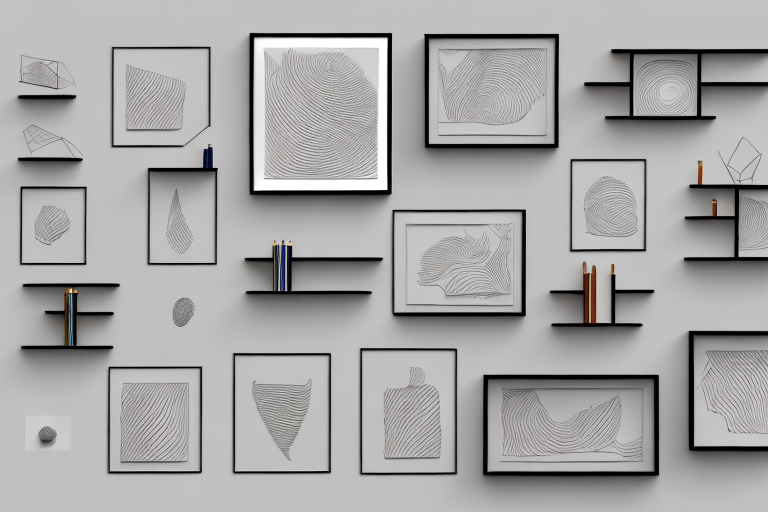How to Choose the Right Type of Wall Shelves
Wall shelves can be a stylish and practical addition to any room. They provide a great way to display and organize items, while also adding a touch of personality to your space. However, with so many different types of wall shelves available, it can be overwhelming to choose the right one for your needs. In this article, we will explore the various types of wall shelves and factors to consider when making your selection, as well as the installation process for each type.
Understanding Different Types of Wall Shelves
Wall shelves are not just functional, but they can also add style and personality to any room. With so many options available, it’s important to understand the different types of wall shelves to choose the one that best suits your needs and complements your decor. Let’s explore some popular types of wall shelves in more detail.
Floating Shelves
One popular type of wall shelf is the floating shelf. As the name suggests, these shelves appear to “float” on the wall, with no visible brackets or supports. Floating shelves can be made from a variety of materials such as wood, metal, or glass, and come in various sizes. They offer a sleek and modern look, making them a great choice for contemporary spaces.
These versatile shelves can be used in any room of the house and are perfect for displaying decorative items, books, or even storing toiletries in the bathroom. They are easy to install and can be mounted on any wall surface.
Imagine having a floating shelf in your living room, showcasing your collection of vintage vinyl records. The minimalist design of the shelf allows the focus to be on the records themselves, creating a stylish and organized display.
Corner Shelves
Corner shelves are designed to fit neatly into the corner of a room, making use of otherwise wasted space. They come in a range of shapes and sizes, from simple triangular shelves to more elaborate designs. Corner shelves are ideal for showcasing small plants, photos, or other decorative pieces. They can also be used in the kitchen for storing spices or displaying your collection of exotic teas.
When choosing corner shelves, consider the size of the corner and the weight of the items you plan to place on them. Some corner shelves require brackets or wall mounts for support, so make sure to follow the manufacturer’s installation instructions.
Imagine having a corner shelf in your bedroom, filled with your favorite books. The cozy nook created by the corner shelf becomes a perfect spot for you to relax and immerse yourself in a good read.
Cubby Shelves
Cubby shelves are perfect for organizing and displaying small items. They feature multiple compartments or cubbies, which can be used to store books, toys, or decorative baskets. Cubby shelves are commonly made from wood and can be wall-mounted or freestanding.
When selecting cubby shelves, think about the size and number of compartments you need. Consider the overall dimensions of the shelf and make sure it fits well in your space. These shelves are a great choice for kids’ rooms or home offices, where organization is key.
Imagine having a cubby shelf in your entryway, with each compartment assigned to a family member. This way, everyone can have their own designated space for keys, wallets, and other small essentials, making it easier to grab and go.
Picture Ledges
Picture ledges are a unique type of wall shelf specifically designed for displaying artwork and photographs. These shelves typically have a shallow depth and a small lip at the front to prevent items from sliding off. Picture ledges provide a versatile and flexible way to showcase your favorite pictures, allowing you to easily switch them out whenever you want.
When considering picture ledges, think about the length you need and the weight of the frames you plan to hang. Some picture ledges require special installation methods, such as drilling holes or using adhesive strips, so be sure to follow the manufacturer’s instructions.
Imagine having a picture ledge in your hallway, filled with a curated collection of family photos. As you walk by, you can reminisce about cherished memories and share stories with your guests.
With so many options available, choosing the right wall shelf can enhance both the functionality and aesthetics of your space. Whether you opt for floating shelves, corner shelves, cubby shelves, or picture ledges, each type offers its own unique advantages. Consider your needs, style preferences, and the specific room where the shelf will be placed to make an informed decision. Happy decorating!
Factors to Consider When Choosing Wall Shelves
Room Space and Layout
Before selecting wall shelves, evaluate your room space and layout. Consider the available wall area where you intend to install the shelves. Measure the height, width, and depth to ensure a proper fit. Take into account any obstructions, such as light switches or electrical outlets, that may affect the placement of the shelves.
Additionally, consider the overall style and design of the room. Choose wall shelves that complement the existing decor and enhance the overall aesthetic appeal.
Purpose of the Shelf
Think about the intended purpose of the wall shelf. Are you looking for a decorative display or additional storage space? Consider the weight capacity and durability of the shelves based on what you plan to place on them. If you have specific items in mind, such as books or collectibles, make sure the shelves can accommodate their size and weight.
Material and Durability
Wall shelves can be made from various materials, each with its own benefits and considerations. Common materials include wood, metal, glass, and plastic. Wood shelves tend to provide a warm and natural look, while metal shelves offer a sleek and modern appearance. Glass shelves can create a more open and airy feel, while plastic shelves are lightweight and easy to clean.
Consider the durability and maintenance requirements of the material. For example, wood shelves may need periodic polishing or refinishing, while metal shelves might require occasional dusting or wiping. Choose a material that suits your preferences and lifestyle.
Style and Aesthetics
Wall shelves come in a wide range of styles and designs to match various decor themes. Whether your preference is contemporary, rustic, or industrial, there is a shelf to suit your taste. Consider the colors, finishes, and decorative elements of the shelves. Think about how they will blend with the existing furniture and accessories in the room.
Remember that wall shelves can also be statement pieces on their own. Don’t be afraid to choose shelves with unique shapes or intricate details to add visual interest to your space.
Installation Process for Different Types of Shelves
Installing Floating Shelves
To install floating shelves, start by marking the desired position on the wall using a level and a pencil. Locate studs or use an anchor system for secure mounting. Place the shelf on the marked position and use a screwdriver or drill to attach it to the wall, following the manufacturer’s instructions.
It is essential to ensure that the shelf is level during installation to achieve a professional and aesthetically pleasing look. Use a level tool to double-check and make adjustments as necessary.
Setting Up Corner Shelves
When setting up corner shelves, start by measuring the height and width of the corner space. Mark the desired position on the wall using a level and a pencil. Depending on the type of corner shelf, use brackets, wall mounts, or adhesive strips for support. Attach the brackets or mounts to the wall and secure the shelf onto them, following the manufacturer’s instructions.
Make sure to distribute the weight evenly across the shelf to prevent any tilting or instability. Use a level tool to ensure that the shelf is aligned correctly and adjust as needed.
Mounting Cubby Shelves
To mount cubby shelves, start by selecting the desired position on the wall. Use a level and a pencil to mark the spots where the shelves will be attached. Depending on the type of cubby shelves, you may need to use brackets or wall mounts for support. Attach the brackets or mounts to the wall and secure the shelves onto them, following the manufacturer’s instructions.
Take care to ensure that the shelves are straight and level during installation. Use a level tool to double-check and make any necessary adjustments.
Hanging Picture Ledges
Hanging picture ledges requires careful positioning and alignment. Start by marking the desired position on the wall using a level and a pencil. Depending on the type of picture ledge, you may need to use brackets, adhesive strips, or drilling holes for mounting.
Attach the brackets, apply the adhesive strips, or insert the wall plugs, depending on the instructions provided. Place the picture ledges onto the supports and make sure they are secure and level. Test their stability by gently applying pressure to ensure they can hold the weight of your frames.
In conclusion, choosing the right type of wall shelves involves understanding the different options available, considering factors such as room space and layout, purpose, material and durability, as well as style and aesthetics. Additionally, make sure to follow the proper installation process for each type of shelf to ensure a secure and visually pleasing display. By taking these considerations into account, you can select wall shelves that not only meet your needs but also enhance the overall look and functionality of your space. Whether you opt for floating shelves, corner shelves, cubby shelves, or picture ledges, you can create a beautiful and organized environment that reflects your personal style.



